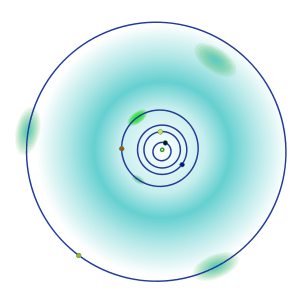2011 UN63
2011 UN63, also written as 2011 UN63, is a Mars trojan, an asteroid orbiting near the L5 point of Mars (60 degrees behind Mars on its orbit).[2][3]
| Discovery | |
|---|---|
| Discovered by | Mt. Lemmon Survey |
| Discovery date | 21 October 2011 |
| Designations | |
| 2011 UN63 | |
Martian L5  | |
| Orbital characteristics[1] | |
| Epoch 13 January 2016 (JD 2457400.5) | |
| Uncertainty parameter 1 | |
| Observation arc | 1587 days (4.34 yr) |
| Aphelion | 1.6222522 AU (242.68547 Gm) |
| Perihelion | 1.4253677 AU (213.23197 Gm) |
| 1.5238099 AU (227.95872 Gm) | |
| Eccentricity | 0.0646027 |
| 1.88 yr (687.06 d) | |
| 101.29418° | |
| 0° 31m 26.298s / day | |
| Inclination | 20.36086° |
| 223.55542° | |
| 165.28918° | |
| Earth MOID | 0.434823 AU (65.0486 Gm) |
| Jupiter MOID | 3.54877 AU (530.888 Gm) |
| Physical characteristics | |
| Dimensions | 560 m |
| 0.5–0.05 (assumed) | |
| 19.7 | |
Discovery, orbit and physical properties
2011 UN63 was first observed on 27 September 2009 by the Mt. Lemmon Survey and given the provisional designation 2009 SA170. Lost, it was re-discovered on 21 October 2011 again by the Mt. Lemmon Survey.[4] 2011 UN63 follows a low eccentricity orbit (0.064) with a semi-major axis of 1.52 AU.[4] This object has moderate orbital inclination (20.4°).[4] It was classified as Mars-crosser by the Minor Planet Center upon discovery. Its orbit is relatively well determined as it is currently (March 2013) based on 64 observations with a data-arc span of 793 days.[1] This asteroid has an absolute magnitude of 19.7 which gives a characteristic diameter of 560 m.[1]
Mars trojan and orbital evolution
Recent calculations[2][3] indicate that it is a stable L5 Mars trojan asteroid with a libration period of 1350 yr and an amplitude of 14°. These values as well as its short-term orbital evolution are similar to those of 5261 Eureka or 2011 SC191.
Origin
Long-term numerical integrations show that its orbit is very stable on Gyr time-scales (1 Gyr = 1 billion years). As in the case of Eureka, calculations in both directions of time (4.5 Gyr into the past and 4.5 Gyr into the future) indicate that 2011 UN63 may be a primordial object, perhaps a survivor of the planetesimal population that formed in the terrestrial planets region early in the history of the Solar System.[2]
See also
- 5261 Eureka
- 1999 UJ7
- 1998 VF31
- 2001 DH47
- 2007 NS2
- 2011 SC191
- 2011 SL25
References
- "JPL Small-Body Database Browser: (2011 UN63)". Jet Propulsion Laboratory. Retrieved 31 March 2016.
- de la Fuente Marcos, C.; de la Fuente Marcos, R. (April 2013). "Three new stable L5 Mars Trojans". Monthly Notices of the Royal Astronomical Society: Letters. 432 (1): L31–L35. arXiv:1303.0124. Bibcode:2013MNRAS.432L..31D. doi:10.1093/mnrasl/slt028.
- Christou, A. A. (2013). "Orbital clustering of Martian Trojans: An asteroid family in the inner solar system?". Icarus. 224 (1): 144–153. arXiv:1303.0420. Bibcode:2013Icar..224..144C. doi:10.1016/j.icarus.2013.02.013.
- MPC data on 2011 UN63
- Further reading
- Three new stable L5 Mars Trojans de la Fuente Marcos, C., de la Fuente Marcos, R. 2013, Monthly Notices of the Royal Astronomical Society: Letters, Vol. 432, Issue 1, pp. 31–35.
- Orbital clustering of Martian Trojans: An asteroid family in the inner solar system? Christou, A. A. 2013, Icarus, Vol. 224, Issue 1, pp. 144–153.
External links
- 2011 UN63 data at MPC
- 2011 UN63 data at AstDyS-2.
- 2011 UN63 at the JPL Small-Body Database